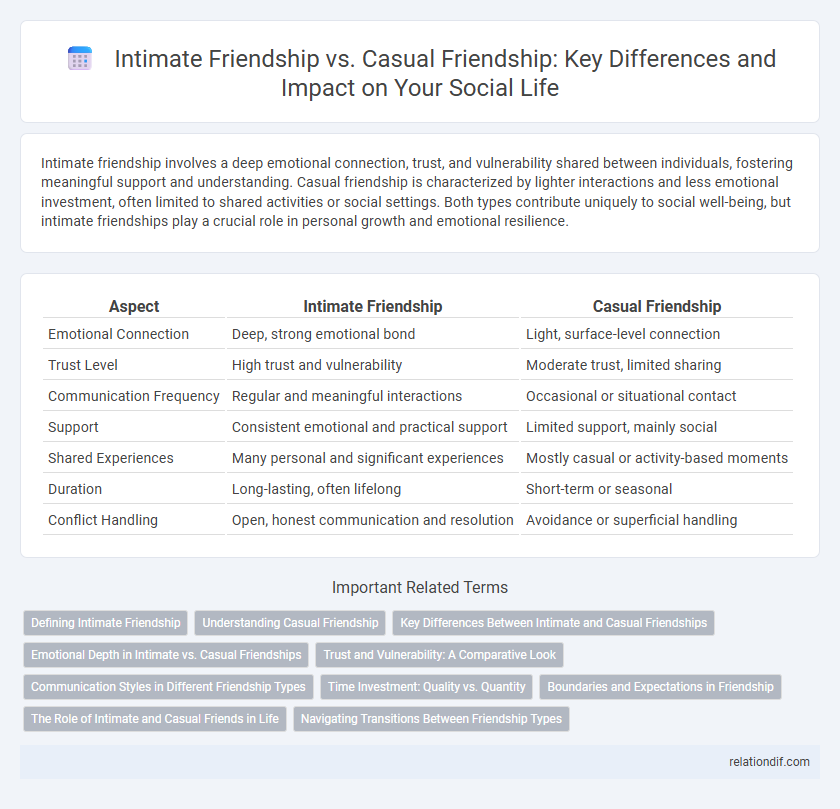Intimate friendship involves a deep emotional connection, trust, and vulnerability shared between individuals, fostering meaningful support and understanding. Casual friendship is characterized by lighter interactions and less emotional investment, often limited to shared activities or social settings. Both types contribute uniquely to social well-being, but intimate friendships play a crucial role in personal growth and emotional resilience.
Table of Comparison
| Aspect | Intimate Friendship | Casual Friendship |
|---|---|---|
| Emotional Connection | Deep, strong emotional bond | Light, surface-level connection |
| Trust Level | High trust and vulnerability | Moderate trust, limited sharing |
| Communication Frequency | Regular and meaningful interactions | Occasional or situational contact |
| Support | Consistent emotional and practical support | Limited support, mainly social |
| Shared Experiences | Many personal and significant experiences | Mostly casual or activity-based moments |
| Duration | Long-lasting, often lifelong | Short-term or seasonal |
| Conflict Handling | Open, honest communication and resolution | Avoidance or superficial handling |
Defining Intimate Friendship
Intimate friendship is characterized by deep emotional connections, trust, and mutual vulnerability, distinguishing it from casual friendship's surface-level interactions. These bonds often involve frequent, meaningful communication and shared experiences that foster a strong sense of loyalty and support. Intimate friendships contribute significantly to emotional well-being by providing a safe space for authentic self-expression and reciprocal understanding.
Understanding Casual Friendship
Casual friendship involves shared interests and occasional interactions without deep emotional commitments, allowing flexibility and low maintenance. It often emphasizes social convenience and comfort rather than vulnerability or intense support, distinguishing it from intimate friendship. Understanding casual friendship fosters healthy social dynamics by recognizing boundaries and appreciating lighter, enjoyable connections.
Key Differences Between Intimate and Casual Friendships
Intimate friendships involve deep emotional connections, trust, and frequent personal disclosures, fostering a sense of closeness and support. Casual friendships are characterized by more superficial interactions, limited personal sharing, and less emotional involvement, often centered around common activities or social settings. The key differences lie in the level of commitment, vulnerability, and duration of the relationship, with intimate friendships requiring more effort and emotional investment than casual ones.
Emotional Depth in Intimate vs. Casual Friendships
Intimate friendships are characterized by profound emotional depth, featuring trust, vulnerability, and mutual support that foster strong emotional bonds. Casual friendships, while enjoyable and supportive, typically maintain a lighter emotional connection with limited sharing of personal feelings. This contrast highlights how emotional intimacy distinguishes close, meaningful relationships from more surface-level social interactions.
Trust and Vulnerability: A Comparative Look
Intimate friendship is characterized by high levels of trust and vulnerability, where individuals openly share personal thoughts and emotions, fostering deep emotional connections. Casual friendship involves moderate trust, with interactions often limited to surface-level conversations and shared activities, reducing emotional exposure. The depth of vulnerability directly influences the strength and resilience of the friendship, making trust a foundational element in intimate relationships compared to casual ones.
Communication Styles in Different Friendship Types
Intimate friendships typically involve deep, open communication characterized by emotional vulnerability, frequent and meaningful conversations, and a strong sense of trust. Casual friendships often feature lighter, more surface-level exchanges focused on shared activities or interests, with less frequent and less personal communication. Understanding these differing communication styles helps individuals navigate social expectations and maintain appropriate boundaries in each friendship type.
Time Investment: Quality vs. Quantity
Intimate friendships require significant time investment focused on quality interactions that build deep emotional connections and trust. Casual friendships prioritize quantity, involving frequent but less personal engagements that maintain social support without intense commitment. Balancing these time investments shapes the depth and longevity of each friendship type.
Boundaries and Expectations in Friendship
Intimate friendships involve clear, mutually understood boundaries that foster deep emotional connection and trust, while casual friendships maintain looser boundaries with limited personal disclosure and lower expectations. Expectations in intimate friendships often include consistent support, honesty, and confidentiality, whereas casual friendships prioritize enjoyable interactions without the pressure of emotional dependency. Defining these boundaries helps protect individual well-being and ensures both types of friendships meet emotional and social needs appropriately.
The Role of Intimate and Casual Friends in Life
Intimate friends provide emotional support, deep trust, and a strong sense of belonging, serving as pillars during life's challenges. Casual friends contribute to social engagement, entertainment, and stress relief, creating a broader social network without the demands of vulnerability. Both roles are essential, balancing emotional depth with social variety to enhance overall well-being.
Navigating Transitions Between Friendship Types
Navigating transitions between intimate friendship and casual friendship requires clear communication and mutual understanding to preserve trust and respect. Recognizing changes in emotional closeness or time investment helps both parties adjust expectations and maintain a healthy connection. Establishing boundaries and sharing feelings openly facilitates smoother shifts and prevents misunderstandings during evolving friendship dynamics.
Intimate friendship vs Casual friendship Infographic

 relationdif.com
relationdif.com